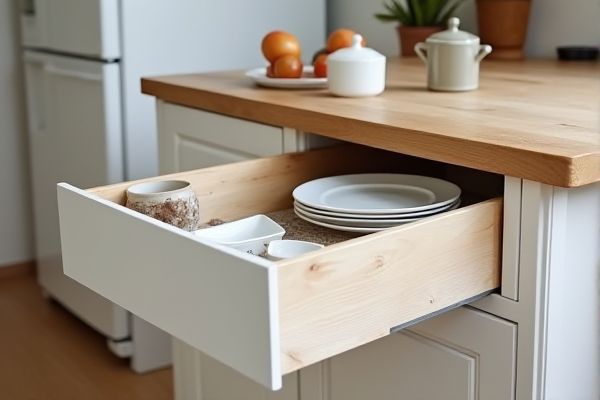
A plate drawer offers organized, space-saving storage by allowing you to easily slide out plates for quick access, while a plate rack typically displays plates upright, making them both functional and decorative. Discover how choosing between a plate drawer and a plate rack can optimize your kitchen's efficiency and style by reading the rest of the article.
Table of Comparison
| Feature | Plate Drawer | Plate Rack |
|---|---|---|
| Storage Type | Enclosed drawer storage | Open vertical or horizontal slots |
| Space Efficiency | Compact, optimized for kitchen drawers | Requires wall or countertop space |
| Accessibility | Easy access when drawer is opened | Quick visual access, plates visible |
| Protection | Protects plates from dust and damage | Exposure to dust and potential breakage |
| Installation | Needs drawer installation or built-in | Simple standalone or wall-mounted |
| Capacity | Limited by drawer size | Varies by rack size and design |
| Style & Design | Sleek, blends with cabinetry | Decorative and functional display |
| Price Range | Moderate to high depending on build | Low to moderate, generally affordable |
Introduction to Plate Drawers and Plate Racks
Plate drawers are specialized kitchen storage solutions designed to keep plates securely stacked in drawers, optimizing space and accessibility within cabinetry. Plate racks, often mounted vertically or incorporated into cabinetry, allow plates to stand upright, facilitating air drying and easy visual access while saving countertop or cabinet space. Both storage options enhance kitchen organization by catering to different spatial needs and aesthetic preferences.
Design and Structure: Plate Drawer vs Plate Rack
Plate drawers feature a pull-out design with individual slots or compartments that securely hold plates flat, maximizing space efficiency and protecting dishes from chips and scratches. Plate racks typically have vertical or inclined slots allowing plates to stand upright, making it easier to access and organize your collection while promoting air circulation for drying. Choosing between a plate drawer and plate rack depends on your kitchen layout and whether you prioritize space-saving design or easy visibility of your plates.
Space Efficiency Comparison
Plate drawers maximize space efficiency by allowing plates to be stacked vertically in a compact, organized manner, utilizing drawer depth to accommodate varying plate sizes without wasting surface area. Plate racks, while visually accessible, generally require more horizontal space due to open shelving and separated slots, which can lead to underutilized storage areas when plates vary in size. For kitchens prioritizing maximum storage within limited cabinetry, plate drawers offer better space optimization compared to plate racks.
Accessibility and Convenience
Plate drawers offer superior accessibility by allowing you to pull out the entire stack of plates for easy reach, minimizing the need to stack or unstack items. Plate racks provide vertical storage but often require you to remove plates from the top down, which can be less convenient during busy kitchen activities. Your choice between a plate drawer and a plate rack will influence how quickly and efficiently you access your dishes daily.
Organization and Storage Capacity
A plate drawer enhances organization by allowing you to stack plates horizontally, maximizing storage capacity and reducing clutter in your kitchen cabinets. In contrast, a plate rack stores plates vertically, which makes accessing individual dishes easier but may limit overall storage capacity compared to a drawer. You can optimize your kitchen space by choosing a plate drawer for bulk storage or a plate rack for quick access and display.
Material and Durability Considerations
Plate drawers often feature solid wood or metal construction, providing enhanced durability and a sturdy base to protect your dishes from damage. Plate racks, typically made from lighter materials like plastic or metal wire, offer less protection but allow better air circulation, reducing moisture buildup. Choosing between the two depends on your preference for robust, long-lasting storage versus lightweight, breathable organization for your plates.
Installation and Maintenance
Plate drawers offer straightforward installation with built-in slides that fit standard cabinets, requiring minimal adjustments. Plate racks typically involve wall mounting or fitting into cabinets, needing careful alignment for secure support and more detailed installation. Your choice impacts maintenance, as plate drawers require occasional track lubrication, while plate racks demand regular dusting and stability checks to ensure safe storage.
Cost Analysis: Plate Drawer vs Plate Rack
A plate drawer typically involves higher upfront costs due to custom cabinetry and hardware installation, whereas a plate rack offers a more budget-friendly, open-storage solution with simpler installation. Long-term maintenance expenses for plate drawers may include occasional hardware repairs, while plate racks require minimal upkeep but offer less protection from dust and damage. Choosing between the two depends on your kitchen design preferences and how you prioritize investment in organized, accessible plate storage.
Aesthetic Appeal in Kitchen Design
Plate drawers offer sleek, minimalist storage that blends seamlessly into contemporary kitchen designs, enhancing aesthetic appeal by keeping plates hidden and countertops clutter-free. Plate racks provide a more traditional or rustic charm, allowing your dishware to become a decorative display that adds warmth and personality to the space. Choosing between the two depends on whether you prefer a clean, streamlined look or an open, visually engaging presentation in your kitchen.
Which Option Suits Your Kitchen Needs?
Plate drawers offer space-efficient storage by stacking plates horizontally, ideal for maximizing cabinet use and protecting delicate dishware. Plate racks, designed for vertical display and ventilation, suit kitchens needing easy access and air drying for plates. Choosing between them depends on kitchen layout, available space, and your preference for accessibility versus storage capacity.
 homyna.com
homyna.com